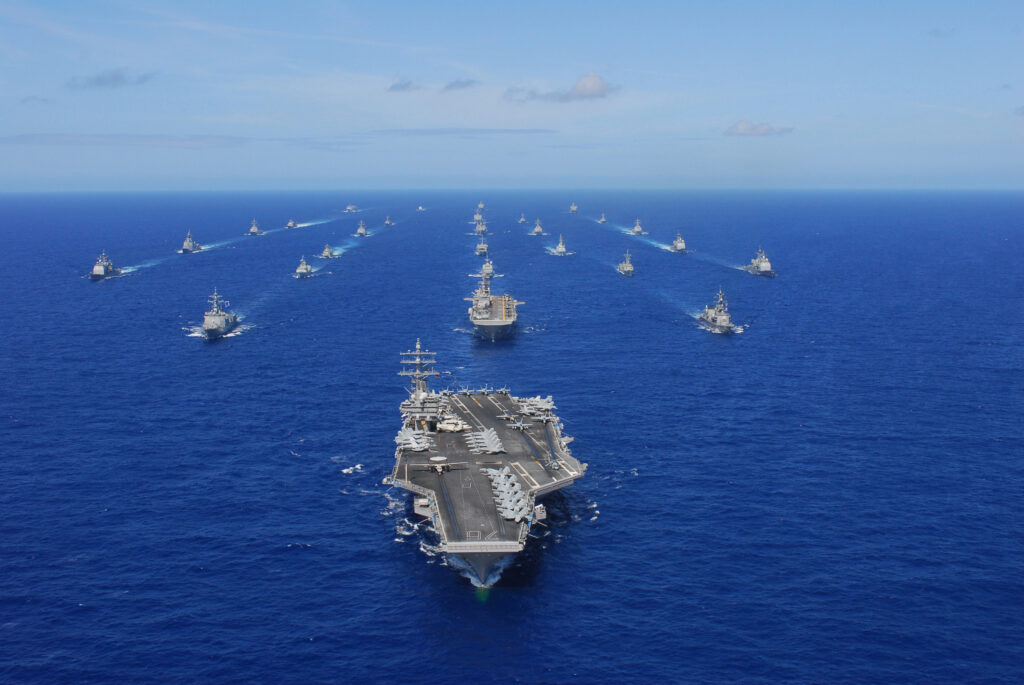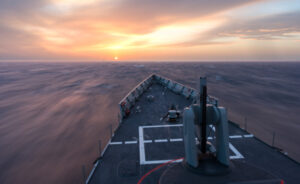A recent Washington Post editorial makes the laudable case for a larger, or at least a more lethal U.S. Navy for checking the rise of China’s navy and for current contingency operations such as shooting down hostile drones and missiles launched by Yemen-based Houthi rebels at maritime targets. The editorial also makes a good case that the Navy needs to do a better job maintaining the ships it has before asking for a larger, more capable fleet.
But what is missing in the discussion about the right size Navy needed to counter these threats is a defined maritime strategy, a type of document not used by the service since the end of the Cold War. A maritime strategy lays out a detailed risk assessment for political leaders and the Office of the Secretary of Defense on the consequences of not meeting naval force projection goals. It drives budgets for new ships, submarines, weapons and research.
The last such strategy in the 1980’s defined what the Navy intended to do in both peace and war and specified the number and types of ships needed for that effort. It also spelled out acceptable risks that lawmakers could consider when thinking about the size and capability of the fleet.
While the Navy has been remiss in providing such a risk assessment in recent years, there is now ample evidence one is needed with significant threats on the rise in the form of two peer competitors (China and Russia) two regional opponents (Iran and North Korea) and the ever-present threat of violent non-state actors such as the Houthi insurgents in Yemen.
Maritime strategies through the decades
When confronting peer maritime opponents such strategies are immensely useful. In the years before the World War II when facing a threat from Imperial Japan, the Navy generated War Plan Orange as a strategy against Japanese aggression. That strategy developed over the course of three decades. When the Soviet Union’s navy became a more global and threatening force after its 1970 OKEAN exercise, Navy Chief of Naval Operations Adm. Elmo Zumwalt began development of what would later become the 1980’s maritime strategy.
Zumwalt did this by refocusing the Navy on war at sea as opposed to power projection ashore in Southeast Asia. Over the next decade Zumwalt and his successors, Adms. Jim Holloway and Tom Hayward, further refined the concept of a maritime strategy and the size and types of ships needed to accomplish the maritime component of national strategy.
Accurate intelligence determined that the Soviets were not really interested in contesting command of the global seas and instead desired to protect their ballistic missile submarines in waters close to the Soviet homeland. Limited budgets always had a say in what the Navy could and could not accomplish and the push for a 600-ship fleet was very much a compromise as 1,000-, 800- and 400-ship fleets were also proposed.
Leaders selected a strategy with a goal of 15 aircraft carriers and 90 nuclear submarines to enable the Navy to contest the Soviets in the Atlantic, the Pacific and in the Mediterranean, while giving up attempts in the Persian Gulf and Indian Ocean. When Ronald Reagan took office in 1980, his Navy Secretary John Lehman aggressively sought support for the Navy’s strategy and force design efforts.
The maritime strategy of the 1980’s has been credited with helping to win the Cold War through its peacetime exercise programs led by officers like 2nd Fleet Commanders Adm. Ace Lyons and Hank Mustin. The Navy did not reach 600 ships, and it remains a hypothetical discussion of how long the budget for a larger fleet could have been maintained. But the combination of the maritime strategy and 600-ship quest as a cornerstone gave the Navy a strong arguing point in Congress that won bipartisan support for both the strategy and ship count for seven years.
Building a new maritime strategy
While it is arguable that the U.S. Navy today should be larger and more capable, having a maritime strategy can make the case for such enlargement with more effectiveness than just referencing current threats. Thirty-year shipbuilding plans would be part of this process but alone are not a substitute for having a strategy and a force design in support.
The 1980’s maritime strategy and 600-ship requirements were not created in Washington D.C., but rather by the fleet commanders who led the Navy in peace and war. Their inputs to the Chief of Naval Operations became the core of the strategy and the fleet size. The Navy should again harness its fleet commanders to build a global strategy with sufficient size and capability. Once armed with these requirements, the Navy can present its case to the Congress and the president for what its commanders think they need to win.
A maritime strategy does not invest the CNO with command powers over the regional deployed commanders, but instead it allows her to build the Navy Program Objective Memorandum, the annual budget submission for the service that supports fleet and joint commander needs. It drives research and procurement budgets, and it provides civilian and military leaders with consistency and direction.
Sadly, there is a recurring myth within the halls of the civilian Office of the Secretary of Defense that such service estimates are wildly out of place and parochial in that they serve only the interests of one service. That fallacy needs to be dispelled and Congress should act objectively on the force requirements that naval professionals provide.
Unlike at the end of the Cold War, the Navy did not have a decade to create the building blocks for maritime strategy. The service must act now and boldly to present Congress and the president with a maritime strategy and fleet size and design to confront current and near-term threats. The Navy needs an aggressive maritime strategy before deciding what to build and in what numbers and lethality.







